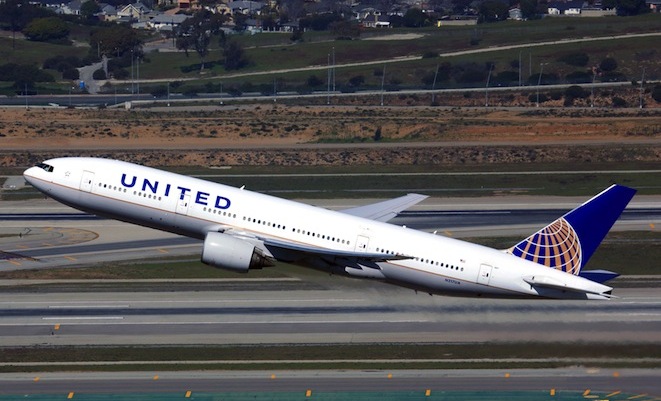
A United Airlines 777 bound for Honolulu was forced to return to Denver on Saturday after it suffered an engine failure shortly after take-off, and rained engine debris on homes and yards in Broomfield, Colorado.
The 26-year-old United Boeing 777, registration N772UA, was performing flight UA328 with 231 passengers and 10 crew on board when the right PW4000 engine failed and caught alight at around 13,000 feet.
The aircraft took off from Denver International Airport at 13:04 on Saturday, when passengers (and onlookers from the ground) reported hearing a large boom around 20 minutes into the flight.
The aircrew radioed the Denver Airport air traffic control (ATC) tower to report the engine failure and declared Mayday. ATC approved the crew to return to Denver.
Powered by its one remaining engine, the aircraft landed safely on runway 26 around 23 minutes after departure.
The aircraft was met by emergency services, which extinguished the active fire in the right engine.
The plane was towed off the runway, where passengers then disembarked and were bussed to the terminal.
The aircraft doesn’t appear to have been grounded or out of use in the 90 days preceding the incident.
No injuries were reported onboard the aircraft, though passengers were understandably shaken up by the experience.
Had a front row seat to the entire engine failure on United flight 328. Kinda traumatized to fly United more. #UnitedAirlines pic.twitter.com/5KdJn1BGfV
— Chad Schnell (@ChadSchnell) February 20, 2021
‘I thought we were done’
“The plane started shaking violently, and we lost altitude and we started going down,” said David Delucia, a passenger onboard flight 328.
“When it initially happened, I thought we were done. I thought we were going down,” he added.
Delucia told the media that he and his wife removed their driver’s licences from their wallets and placed them in their pockets so that they could be quickly identified “in case we did go down”.
Passengers took to Twitter with photos and videos of the Pratt and Whitney engine on fire at over 10,000 feet.
@united @9NEWS
My video from the air. We are all okay and about to board the next plane. Thanks to everyone for reaching out! pic.twitter.com/KegqXvAgw5— Brett Guy (@bguyzer) February 21, 2021
At the same time, witnesses on the ground also heard the engine explode, and watched as debris from the smoking plane fell to the ground throughout the Denver suburb of Broomfield, Colorado.
Broomfield police confirmed that a number of large pieces of engine debris impacted the neighbourhood, striking roads, vehicles, yards and some homes.
However, the police have said that no one on the ground was injured by the falling debris.
New video of @united engine debris crashing to the ground in Broomfield. Sound up! From Mark Moskovics pic.twitter.com/X8OvKfSUpH
— Matt Mauro (@mattmauronews) February 21, 2021
Local resident Tyler Thal told the ABC he was out for a walk with his family when he noticed the plane flying unusually close to the ground.
“While I was looking at it, I saw an explosion and then the cloud of smoke and some debris falling from it,” Thal said.
Meanwhile, resident Kirby Klements was inside his home with his wife when they heard the explosion, and saw debris fly past their window.
The engine part, approximately 4.5 metres in diameter, smashed into Klement’s truck, causing extensive damage.
“And if anyone had been in the truck, they would have been dead,” he said.
**2 Hours Ago**
Parts of a plane fall from the sky in Colorado
A United Airlines flight bound for Honolulu experienced engine failure shortly after takeoff from Denver International Airport on Saturday, causing debris from the plane to rain down on a Denver suburb. pic.twitter.com/kNyOWnZFOm— RossRadio (@cqcqcqdx) February 21, 2021
The US National Transportation Safety Board has said the plane suffered a catastrophic and uncontained engine failure, and will be continuing an investigation into the cause of the incident.
Aviation experts have noted that an incident such as this is most likely to occur just after take-off, due to the strain placed on the engines at that time.
Aviation analyst Miles O’Brien added: “Generally speaking, you’re stressing the system on departure. That’s when the system is doing the most work.”
The incident occurred on the same day as another aircraft powered by PW4000 series engines experienced a single-engine failure, and rained down debris.
A Longtail Aviation Boeing 747-400 converted freighter, registration VQ-BWT, was flying from Maastricht in The Netherlands to New York JFK when its own Pratt and Whitney engine suffered severe damage and began to shed engine parts over the village of Meerssen below.
The debris hit an elderly lady, causing minor injuries, as well as a number of cars throughout the Dutch village.
The crew declared PAN PAN, then Mayday, and reported they had lost the engine.
The aircraft stopped the climb at 10,000 feet, entered a hold to dump fuel, before landing safely at Liege in Belgium about one hour after its initial departure.










